
|
SUMMARY:
Most professional service firms struggle to turn their hard-won expertise into a steady stream of qualified leads. Here’s how one law firm used AI to change that – without risking their reputation or data. |
Action Box: AI workflow can help do this with you
MeclabsAI can do it with you. Try the multi-agent workflow How To Turn Professional Expertise into an AI-Powered Lead-Gen Engine (MeclabsAI is MarketingSherpa’s parent company).
The largest payout in the history of U.S. copyright cases. That’s what Anthropic agreed to last month. The suit alleged Anthropic used copyrighted books to train Claude, according to NPR.
Here’s my take on it. The ‘artificial’ mechanisms are a commodity tool. So even AI behemoths need to go to great lengths to bring that mechanism ‘intelligence.’
The good news for you – your brand, company, and/or clients already have that intelligence. You don’t need to search the web for others copyrighted work. You just need to use the commodity mechanism (AI) to put that intelligence into action.
Let’s dive in to see how you can do it. This article is different than recent MarketingSherpa how-to articles. Instead of going broad, we go deep – looking at how one specific company (Law Offices of David L. Carrier, P.C.) used one specific platform (MeclabsAI, parent company of MarketingSherpa) to give you ideas for your own company or clients.
Start by clarifying the unique knowledge your company brings to the table. List your brand’s core competencies and identify the problems your team solves.
Then determine your ideal customer/audience. Who do you best help with this information and these skills? Hint: It can’t be ‘everyone.’ When you try to serve everyone, you serve no one.
Once you understand who your brand should be speaking to, the messaging in your AI can address potential clients’ challenges head-on and use language that is familiar to them.
This is the foundation. Without a precise definition, your new lead-generating system will not have a powerful process-level value proposition. In other words, fewer of the people you are trying to reach will see value in it and want to interact with it.
Carrier Law had spent decades refining its expertise and audience. David Carrier has two law degrees – a Juris Doctor (JD) from Boston University School of Law and a Master of Studies in Law in Taxation from Georgetown Law. His firm specialized in estate planning and elder law and estate planning based on this taxation expertise.
While that is a start for where to focus, it’s really just a high-level subset of an industry. A good understanding of your expertise and audience should do deeper. It should get visceral. You should feel the ideal customer’s pain and triumph along with them when they meet their goals.
And when I talked to Carrier, he sounded like a man on a mission. “Middle-class families are jammed when it comes to long-term care,” said David Carrier, attorney, Law Offices of David L. Carrier, P.C. “And when it comes to tax benefits, what the middle class gets are crumbs from the rich.”
That right there is a firm understanding of the audience. Now let’s get to the expertise.
“[Other lawyers say] you need the trust because the trust will avoid probate. That's how they sell them. Avoid probate,” Carrier said. “But there's no follow through. And because there's no follow through, the trust doesn't actually work.”
He outlined four things his firm does that is different:
Once you have an understanding of who you can help and how you can help them, take a step back and determine how you are currently showing up for them online.
AI isn’t about technology – it’s about serving your customer. Map your ideal customer’s journey. Identify what information they need, and when.
Then determine – how are you currently serving those prospects?
Examine your existing website and digital assets. Evaluate the effectiveness of your site. Where are you trying to serve the prospect with traditional web elements, but could serve them better with interactive, AI-based interfaces?
Some examples to get you thinking:
If you’re like many marketers, you’ve probably focused your site on simple, scannable content. But your ideal customer may have complex challenges that aren’t easily addressed. Since AI brings interactivity, it can help enable you to break content into actionable chunks and optimize for user engagement by serving visitors with the pieces of information they most need in the moment, based on their questions and interactions.
For Carrier Law, the customer journey looked like this:
The law firm had already worked on revamping its site to better serve prospects. “At a high level, he had a classic website. And he'd already gone through the stages of optimization to try and improve the response rate,” said Flint McGlaughlin, CEO, MeclabsAI (the AI platform Carrier Law used).
The team identified two opportunities for incorporating AI:
An AI-powered agent can transform your passive website into an interactive lead gen machine. Here are the steps you can take:
Use your interviews, presentations, blog posts, and other professional materials as source material.
For the Carrier Law agent, the team first put the Carrier Law website into MeclabsAI Agent Builder.
Creative Sample: MeclabsAI Agent Builder

They then further refined the information with specific articles, interviews, internal documents, and even a book written by David Carrier.
“We took IP (intellectual property) that we found on David's website – his interviews, his articles, etc. We trained an agent in his field of expertise with his own IP. We also train the agent with the Meclabs conversion methodology,” McGlaughlin said.
This content then enables the AI agent to answer questions like ‘How do I avoid probate, save taxes, and benefit my children or other beneficiaries?’ and ‘How do I avoid nursing home poverty?’
“It's not legal advice. It's like writing an article or a radio show or answering a question on Avvo.com,” Carrier said. “That's not a legal advice. That's just interesting information.”
Give the AI instructions on how you would like it to behave and serve the customer, along with the content you have gathered. Here is an approach you can use:
In the case of Carrier Law, the team integrated core user experience elements from the Meclabs methodology that are built into MeclabsAI, including empathy cues and conversion methodologies.
“Of course, an AI agent can't have empathy,” McGlaughlin explained. “But David Carrier, the man behind it, does. And we can extend that empathy right into the training of the agent.”
Creative Sample: AI agent with empathetic tone

“This is not a chatbot, that's like calling a flip phone a smartphone. They're completely different animals,” he said. McGlaughlin described the platform as a purpose-built digital assistant harnessing your expertise to deliver meaningful advice and a clear CTA that drives people to take the next step.
In addition to typing with the agent, the visitor has the option to dictate by clicking on the microphone in the lower right, and the agent will transcribe the visitor’s word. Or they can click on the clue circle in the lower-right to have a full voice conversation.
“The visitor can go back and forth talking with this agent if they don't want to type, and remember this demographic is often an older demographic,” McGlaughlin said.
Creative Sample: Voice conversation mode of AI agent for estate planning law firm

When you put an AI agent on your website, there are two levels of triggers to consider.
First, you want to set the mechanism (clicks, time on page, scrolling behavior) that will prompt the AI agent to engage the visitor.
The team used the MeclabsAI Agent Delivery System (ADS).
Creative Sample: MeclabsAI Agent Delivery System (ADS) creator

With the ADS creator, they placed a rotating series of questions in the bottom center of the Carrier Law website a few moments after a visitor arrived. The agent loads when a visitor clicks on a question.
Creative Sample: Trigger questions on law firm website

The second set of triggers you want to consider involves the next step for the user to take. The team set a pop-up for the free workshop to appear 20 seconds after a visitor starts interacting with the agent.
Creative Sample: Workshop CTA in law firm's AI agent

The agent also encouraged visitors to take the next step in more passive ways:
That last way of encouraging visitors to take the next step provided a surprising result. “We were stunned at how many people gave us phone numbers and said, ‘call me’ – right in the ADS,” McGlaughlin said. “That is happening every week now.”
Now that your AI agent is in place, it’s time to refine how you guide your ideal customers through your sales funnel. They enter your funnel from the AI agent…and then what?
Don’t add steps just because you can. Keep your system clean and efficient by avoiding jargon and unnecessary steps. To help you do that, and identify opportunities where AI really can help your potential customers as well as lead funnel performance, you can look at your funnel through three lenses:
In the case of Carrier Law, the team saw that AI gave them an ability to do these three things in a new way after ideal prospects attended a workshop. The team used MeclabsAI to create a financial threat assessment for prospects. Instead of selling them on a solution, the team was able to provide a clear understanding so the prospect could see for themselves how much they did (or didn’t) need the solution.
“It's not heavy handed, it's not hype, it's part of the solution. And you get a lot of value that it's embedded within. So, it's not your traditional lead device, which is all promise and mostly BS,” McGlaughlin said.
There were two ways prospects could take the financial threat assessment.
First, they could talk to someone from the Carrier Law team on the phone, who would walk them through it. The Carrier Law team member inputs the prospects responses into MeclabsAI, which would then write a custom report for that individual complete with a cover letter written in the style of David Carrier himself (because the MeclabsAI expert had been trained in his writing style).
The report includes:
The team then prints out the cover letter and the report and sends it via FedEx to the prospect.
They also created a self-servce MeclabsAI workflow that prospects could go through online. The language was clear and actionable – the simple language the team would use when speaking directly to a prospective client.
Creative Sample: Financial threat assessment AI workflow for elder law firm

“AI enables us to do this risk assessment,” Carrier said. “It analyzes it and tells the prospect what their risk level is and what they should be doing next. It also generates a cover letter that re-emphasizes points bringing in personal information. Before we couldn't afford to do that. It was too expensive. But with the AI now, we can give them a very personal report that is unique to them and informative and helpful and all those good things. That's what the AI enables you to do.”
A lead gen engine needs constant fine-tuning. Especially something as new as an AI-enabled funnel – you just don’t know how prospects will react. So make sure you:
But you don’t only have to use things you learn from the AI in the artificial intelligence agent itself. You can take those lessons and apply them to other parts of your funnel.
For example, the Carrier team gets a regular analysis from MeclabsAI about interactions prospects have had with it. The report includes:
David Carrier then used that information to inform him about the topics he should discuss on his radio show, one of the channels that attracts people into the funnel.
"The problem with getting feedback through the radio show is the sample size of people willing to call on Sunday morning is pretty small. If I get three or four callers, that's great. But a lot of people seem to listen passively and enjoy it because people always say to me, 'Oh, I love your radio show,’” Carrier said.
Since the AI agent has had 1,724 interactions so far, the analysis reports give Carrier a much better idea what topics would interest and attract more of his ideal customer.
Your first use of a curated digital assistant to convert passive interest into tangible leads is likely a pilot. It’s new. You’re trying things out. You’re gauging response.
But as you learn, you’re also building a proof point for what really works. And what else you can do with it.
For Carrier Law, their new AI-assisted funnel has produced these results:
After he worked with the MeclabsAI team to build an AI-powered agent for his website and an AI-powered ‘Threat Assessment’ for his event, Carrier went from an attorney with no AI experience to an evangelist.
Within Carrier Law, the team is now experimenting with how AI can help it with its internal processes and operations, similar to how AI made the financial threat assessment possible.
And the team is also looking at expanding the AI-assisted funnel. While Carrier Law itself has four offices in Western Michigan and is focused on serving that area of the country, David Carrier and his partners have formed Red Wagon Law Firm in partnership with attorneys in 11 states. And he recently shared what he’s learned about AI with these other lawyers. "They were very receptive to the idea of putting an AI agent on their website,” he said.
So how can you use AI to add value for you organization? I asked McGlaughlin what advice he would give to marketers and entrepreneurs based on his experience.
“It's too early to re-engineer your entire tech stack. I've been through three of these revolutions – the PC revolution, the Internet revolution, and now this one. And most people made big bets, and most of them got them wrong,” McGlaughlin said.
“What you do now is create net new ways to impact your P&L and still silo and protect your data. Either focus on what you see David doing in the back office that produces savings in time and thus money, or focus on what you can do customer facing that drives more top line. You can do this without taking enormous risk, because you're not jeopardizing your personal data, and you're not betting hundreds of thousands of dollars on what platform you're going to need. It's too early to know that information. This is the safe, prudent path to have P&L impact before all of your competitors without jeopardizing your business's long-term health,” he advised.
Website Strategies: 4 ways to prepare your marketing team to increase conversion rates
How to build a lead gen campaign with your content
Open-Source Start-up Marketing Strategy: Sometimes you need to poke the snake (podcast episode #147)
Get Better Business Results With a Skillfully Applied Customer-first Marketing Strategy

The customer-first approach of MarketingSherpa’s agency services can help you build the most effective strategy to serve customers and improve results, and then implement it across every customer touchpoint.
Get More Info >MECLABS AI
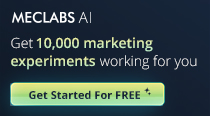
Get headlines, value prop, competitive analysis, and more.
Use the AI for FREE (for now) >Marketer Vs Machine
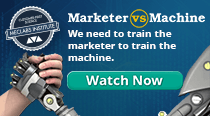
Marketer Vs Machine: We need to train the marketer to train the machine.
Watch Now >Live, Interactive Event

Join Flint McGlaughlin for Design Your Offer on May 22nd at 1 pm ET. You’ll learn proven strategies that drive real business results.
Get Your Scholarship >Free Marketing Course

Become a Marketer-Philosopher: Create and optimize high-converting webpages (with this free online marketing course)
See Course >Project and Ideas Pitch Template

A free template to help you win approval for your proposed projects and campaigns
Get the Template >Six Quick CTA checklists
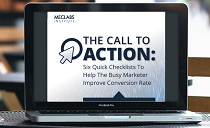
These CTA checklists are specifically designed for your team — something practical to hold up against your CTAs to help the time-pressed marketer quickly consider the customer psychology of your “asks” and how you can improve them.
Get the Checklists >Infographic: How to Create a Model of Your Customer’s Mind
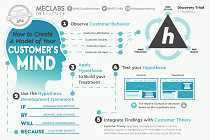
You need a repeatable methodology focused on building your organization’s customer wisdom throughout your campaigns and websites. This infographic can get you started.
Get the Infographic >Infographic: 21 Psychological Elements that Power Effective Web Design
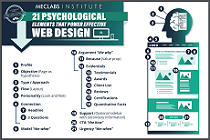
To build an effective page from scratch, you need to begin with the psychology of your customer. This infographic can get you started.
Get the Infographic >Receive the latest case studies and data on email, lead gen, and social media along with MarketingSherpa updates and promotions.